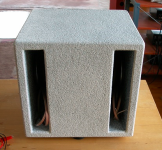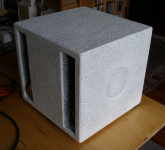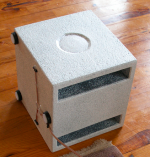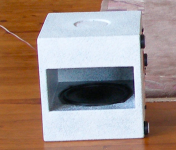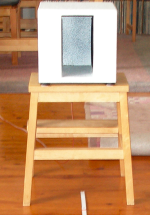Several years ago, the N or W bass dipole was all the rage, in Germany with the RiPol seal of approval. I had no idea what kind of miracle it was supposed to be, but I liked the cube shape - and after a friend surprised me with his handicraft work, I was surprised too. In the following years I wanted to glue such a frame as a holder for the cheapest chassis: Visaton WS-20E in series connection. This experiment was not about abysmally dry low bass with punch, but simply about feasibility. And the question of feasibility and simulation. In the end I ended up with AkAbak (win16), the only program that really simulates correctly. Unfortunately, Axel won't hand over his script (or the script generator) and AJ-Horn's dad isn't any more helpful when asked, so I has to get to work myself.
I rediscovered the project almost 14 days ago and since then a mono sub has been working in the living room to support the main loudspeakers whenever I switch on the chinese ReckHorn A409 wonder box.
{
Memb: Sd=232
Korb: Dmax=20
HINTEN:
[cm] : 54(H:B:T) 22 5 27
VORNE:
[cm] : 76(H:B:T) 22 16 27
( 8 <B< 16)
B2(Startwert)= 12 [cm]
EXTRAS:
Ah 47.4%
Av 113.7% ... von Sd
Vh= 2.97 Vv= 7.128 [ltr.]
--------------------------------------------------------------
(minimale) Höhe : 22[cm]
(maximale) Tiefe : 27[cm]
(Start) Breite: 5& 12[cm]
--------------------------------------------------------------
}
I didn't use x % of Sd and all that nonsense as a benchmark for the chamber sizes, but took the effective diaphragm circumference as a first point of reference. In other words, the rear chamber (Vh & Ah), or the folds, as you like ... has this circumference as an emerging rectangular area as the basis for all subsequent geometric dimensions.
As you can see, the front chamber (Vv & Av) is quite large. Why? Because I wanted a certain broadbandness of the sub-frequency range and no extreme attenuation of the driver's free-air resonance. At the moment the cube is set up to support the stereo speakers extremely cleanly from 20Hz to 100Hz - it acoustically places the instruments on a new acoustic basis. No more and no less, obviously the location and differentiation possibilities of the instruments and voices are very clearly improved. More air, more lightness ... interesting
tbc
I rediscovered the project almost 14 days ago and since then a mono sub has been working in the living room to support the main loudspeakers whenever I switch on the chinese ReckHorn A409 wonder box.
{
Memb: Sd=232
Korb: Dmax=20
HINTEN:
[cm] : 54(H:B:T) 22 5 27
VORNE:
[cm] : 76(H:B:T) 22 16 27
( 8 <B< 16)
B2(Startwert)= 12 [cm]
EXTRAS:
Ah 47.4%
Av 113.7% ... von Sd
Vh= 2.97 Vv= 7.128 [ltr.]
--------------------------------------------------------------
(minimale) Höhe : 22[cm]
(maximale) Tiefe : 27[cm]
(Start) Breite: 5& 12[cm]
--------------------------------------------------------------
}
I didn't use x % of Sd and all that nonsense as a benchmark for the chamber sizes, but took the effective diaphragm circumference as a first point of reference. In other words, the rear chamber (Vh & Ah), or the folds, as you like ... has this circumference as an emerging rectangular area as the basis for all subsequent geometric dimensions.
As you can see, the front chamber (Vv & Av) is quite large. Why? Because I wanted a certain broadbandness of the sub-frequency range and no extreme attenuation of the driver's free-air resonance. At the moment the cube is set up to support the stereo speakers extremely cleanly from 20Hz to 100Hz - it acoustically places the instruments on a new acoustic basis. No more and no less, obviously the location and differentiation possibilities of the instruments and voices are very clearly improved. More air, more lightness ... interesting
tbc
Attachments
Last edited:
ripol3.zip
is a win32 console; After entering the effective diaphragm /membrane area and the basket diameter (mounting circle), this calculator spits out the first internal dimensions, i.e. reference points for the AkAbak _duct s.
is a win32 console; After entering the effective diaphragm /membrane area and the basket diameter (mounting circle), this calculator spits out the first internal dimensions, i.e. reference points for the AkAbak _duct s.
Surface and volume requirements (outside):
W:29,2cm * D:28,4cm
H:27,3cm plus feet
Dimensions:
Front chamber (inside)
W:12cm * D:26.7cm times H:23.2cm
Back chamber (inside), left
W:4.5cm * D:26.7cm times H:23.2cm
Back chamber (inside), right
W:4.5cm * D:26.7cm times H:23.2cm
TSP's:
Rdc=3.394Ohm
fso=38.347Hz
|Zmax|=12.5Ohm
|Z1k|=5.05Ohm
|Z10k|=17.14Ohm
Qms=2.919
Qes=1.088
Qts=0.793
Sd=232cm^2
Mms=23.3g
Cms=0,71 mm/N
Vas=55.714ltr
BL=4.179Tm
Rms=1.918 kg/s
Data that completely contradict the classic opinion of a suitable RiPol driver. And then also a BMC configuration in electrical series connection.
Remark
The TSP are extrapolated values that (could) occur in daily operation. At the time, I simply thought that a Qes of almost 1 would be ideally suited as an openbaffle concept.
W:29,2cm * D:28,4cm
H:27,3cm plus feet
Dimensions:
Front chamber (inside)
W:12cm * D:26.7cm times H:23.2cm
Back chamber (inside), left
W:4.5cm * D:26.7cm times H:23.2cm
Back chamber (inside), right
W:4.5cm * D:26.7cm times H:23.2cm
TSP's:
Rdc=3.394Ohm
fso=38.347Hz
|Zmax|=12.5Ohm
|Z1k|=5.05Ohm
|Z10k|=17.14Ohm
Qms=2.919
Qes=1.088
Qts=0.793
Sd=232cm^2
Mms=23.3g
Cms=0,71 mm/N
Vas=55.714ltr
BL=4.179Tm
Rms=1.918 kg/s
Data that completely contradict the classic opinion of a suitable RiPol driver. And then also a BMC configuration in electrical series connection.
Remark
The TSP are extrapolated values that (could) occur in daily operation. At the time, I simply thought that a Qes of almost 1 would be ideally suited as an openbaffle concept.
Last edited:
At that time, countless speculations circulated in the form of convoluted ideas regarding the operating principle. The all-important question was always how low a given free-air resonance could be achieved. In fact, it's all quite simple and has to do with the mass coupling; it was made into a big secret and ennobled with a dubious patent.
{
1: DRS |_| 2: BMC ? 2
[g] Mms=23.238
[mm/N] Cms=0.71
[cm^2] Sd=232
2.000085[g] 1.694987[ltr.]
[Ohm] Rdc=3.394
[Tm] Bl=4.179
[kg/s] Rms=1.918
2.982783 1.111827 0.8099279
[ltr] Vh=2.537
[cm^2] Ah=104.4
Cmh= 0.05532466 [mm/N, S^2/kg]
[ltr] Vv=7.433
[cm^2] Av=278.4
Cmv= 0.03735676 [mm/N, S^2/kg]
fres= 25.29986[Hz] 50.47617[g] 0.784003[mm/N]
2.702503 1.559378 0.9888179
}
A simple calculator method provides: 25.3Hz (mounted as an open baffle, in the form of a frame construction) versus the extrapolated free air resonance of 38.35Hz. AkAbak and measurements confirm this simple calculation example very well.
tbc
{
1: DRS |_| 2: BMC ? 2
[g] Mms=23.238
[mm/N] Cms=0.71
[cm^2] Sd=232
2.000085[g] 1.694987[ltr.]
[Ohm] Rdc=3.394
[Tm] Bl=4.179
[kg/s] Rms=1.918
2.982783 1.111827 0.8099279
[ltr] Vh=2.537
[cm^2] Ah=104.4
Cmh= 0.05532466 [mm/N, S^2/kg]
[ltr] Vv=7.433
[cm^2] Av=278.4
Cmv= 0.03735676 [mm/N, S^2/kg]
fres= 25.29986[Hz] 50.47617[g] 0.784003[mm/N]
2.702503 1.559378 0.9888179
}
A simple calculator method provides: 25.3Hz (mounted as an open baffle, in the form of a frame construction) versus the extrapolated free air resonance of 38.35Hz. AkAbak and measurements confirm this simple calculation example very well.
tbc
Attachments
The next exciting point was the resulting chamber (main) resonance (or resonances) - and the ever-present question of whether the secret of the design can be uncovered using degenerate BR ideas and disguised Helmholtz resonators?
{
Innenmaße:
[cm] H=23.2
[cm] B(h)=9
[cm] B(v)=12
[cm] T=26.7
Ah= 208.8 Av= 278.4[cm^2] Dh= 16.30498 Dv= 18.82737[cm]
Treibermaße:
[cm] Membran=20.5
[cm] Tiefe=5
[cm] Magnet=7
V1= 0.1924225616455078 V2= 0.55010595703125 V3= 0.3712642517089844[ltr]
Raumbedarf:
[ltr] V_Chassis=0.4
Helmholtz:
[cm],[Hz]
16.1 274.08
12.8059 307.316
17.6 252.5612
14.78698 275.539
fres= 277.3741[Hz]
Zeiger, Vektoren:
Seite 24.88453 28.17605 36.49836 [cm]
Mitte 26.11972 29.27268 37.35144 [cm]
fres= 332.4295[Hz]
Erweitert:
163.9911 218.6549 [cm^2]
3978.564 5838.085 [cm^3]
5.17496044921875 7.43328076171875 [ltr]
}
Of course, the chambers are not Helmholtz resonators, but nothing more than masses, oscillating, dynamically coupled masses. There's no BR principle at work. And yet, using spatial diagonals, one can already approximate the nasty, unwanted cavity resonance in advance. Again, using a calculator method, confirmed by simulation (AkAbak; no other program I know of simulates this more accurately) and electrical and acoustic measurements (near and far field).
In the further course of events, not so long ago a small dispute broke out, a challenge from Axel R. to Leo Kirchner ..!
#
Attached is my TR - a win32 console.
tbc
{
Innenmaße:
[cm] H=23.2
[cm] B(h)=9
[cm] B(v)=12
[cm] T=26.7
Ah= 208.8 Av= 278.4[cm^2] Dh= 16.30498 Dv= 18.82737[cm]
Treibermaße:
[cm] Membran=20.5
[cm] Tiefe=5
[cm] Magnet=7
V1= 0.1924225616455078 V2= 0.55010595703125 V3= 0.3712642517089844[ltr]
Raumbedarf:
[ltr] V_Chassis=0.4
Helmholtz:
[cm],[Hz]
16.1 274.08
12.8059 307.316
17.6 252.5612
14.78698 275.539
fres= 277.3741[Hz]
Zeiger, Vektoren:
Seite 24.88453 28.17605 36.49836 [cm]
Mitte 26.11972 29.27268 37.35144 [cm]
fres= 332.4295[Hz]
Erweitert:
163.9911 218.6549 [cm^2]
3978.564 5838.085 [cm^3]
5.17496044921875 7.43328076171875 [ltr]
}
Of course, the chambers are not Helmholtz resonators, but nothing more than masses, oscillating, dynamically coupled masses. There's no BR principle at work. And yet, using spatial diagonals, one can already approximate the nasty, unwanted cavity resonance in advance. Again, using a calculator method, confirmed by simulation (AkAbak; no other program I know of simulates this more accurately) and electrical and acoustic measurements (near and far field).
In the further course of events, not so long ago a small dispute broke out, a challenge from Axel R. to Leo Kirchner ..!
#
Attached is my TR - a win32 console.
tbc
Attachments
Yes!Any measurements? I like how it looks like a BP4 in the front and a BP6P in the back.
They're all there and very comprehensive. Unfortunately, everything is a bit scattered across various notebooks; I still have to compile it all—or rather, sort through it. The project was complete for me; everything I wanted to know back then was achieved—and what's left is essentially the DUT from post one. It sat in the corner, gathering dust... but the topic of N or W poles is too interesting to be forgotten. The entire interplay with space... etc. This (the integration and number of Sub's, the space, the main speakers, ...) is much more complex than just a simple recipe, as a how to build guide.
First of all, it really is a dipole and the radiation pattern corresponds (also) to that which Axel R. has already published many times.
HBt.
- Home
- Loudspeakers
- Subwoofers
- my RiPol : the unknown creature

